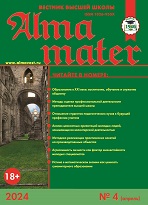UDC 37.09-042.3:332.1
https://doi.org/10.20339/AM.12-20.063
V.G. Lizunkov is Cand.Sci. (Pedagogy), Ass. Prof. at Yurga Technological Institute — Branch of National Research Tomsk Polytechnic University and at Ural State Economic University e-mail: vladeslave@rambler.ru
Presented are results of the authors’ research in the context of principles of projecting the system of training needed specialists on territories of advance development of advanced social economic development (ASED). Presented are three principal stages, characterized internal logic of formation of the system of ASED. Revealed is successive algorithm of variative projecting of the system of training of needed specialists in ASED. Defined are key targets of projecting of the system, and among them are strategic ones, determining by distant results of development of professional training, tactical ones, connecting with changes in the system on stages, and also operational ones, needed for solution of problems in the course of projecting. Described are key features of the system of training needed specialists on ASED, incl. actual skills of future specialists in the sphere of machine building, principal of which are informational, valuable, entrepreneurial and introduction ones. Fixed is, that building of the system of training a specialist, needed on ASED, must be made with the use of projection of named factors as to chosen territory.
Key words: specialists, system of training, ASED, projecting, algorithm, needed cadres.
References
1. Kadyrova, Kh.R. Variation system of many-leveled training of cadres for regional machine building enterprises on the base of integrative approach. Kazan, 2013.
2. Kovalevsky, V.P. Concept of integral target management by regional university complexes. Integration in education. 2004. No. 2. P. 25–31.
3. Ibragimov, G.I. Evaluation of competences: problems and solutions. Yigher education in Russia. 2016. No. 1. P. 43–52.
4. Jarvis, P. The Sociology of Adult and Continuing Education. London, 1985.
5. Yavorsky, O.E. Educational claster as a form of social partnership technology and enterprises in gas producing branches. Kazan, 2008.
6. Khutorskoy, A.V., Khutorskaya, L.N. Competence approach to modeling of post-diploma education. In: Theory and practice of post-diploma education. Grodno, 2003. P. 256–260.
7. Kachugina, T.V. Modeling of professional educational space of small industrial city. Kazan, 2009.
8. Bekrenev, A.N. Integrative system of higher engineering education. Higher education in Russia. 1994. No. 2. P. 125–128.
9. Kadyrova, Kh.R. Modern approaches to training of labor resources for enterprises machine building branch. In the world of scientific discoveries. 2009. No. 6. P. 60–65.
10. Dakhin, A.N. Pedagogic modeling: essence, efficiency and non-determination. Pedagogy. 2003. No. 4. P. 21–26.
11. Lizunkov, V.G. Prognosis of influence of innovative factors of economic growth on state of labor market. In: Innovative technologies and economic in machine building. Tomsk, 2010. P. 375–376.
12. Alasheev, S.Yu. Methodic of average period prognosis of demand for labor resources in the system of regional professional education. URL: http://www.labor market.ru?Pages/conf1
13. Klyachko, T.K. Prognosis for development of higher education in Russia: 2009–2011. Moscow, 2009.
14. Saveliev, A.Ya. Analysis and evaluation of state and development of higher and medium professional education. Moscow, 2002.
15. Saveliev, A.Ya. Problems of prognosis in development of professional education in Russia. URL: http://www.asms.ru/kompet/2011/june/saveliev15.pdf
16. Shamova, T.I. Formation of normative legal competence of pedagogical cadres. Moscow, 2006.
17. Shishov, S.E. Competence approach to education: fancy or necessity. Standards and monitoring in education. 2002. No. 2. P. 58–62.











.png)






